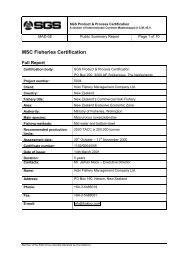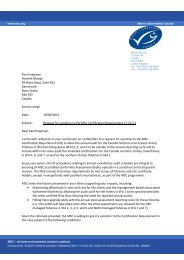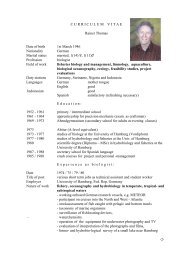SGS Product & Process Certification - Marine Stewardship Council
SGS Product & Process Certification - Marine Stewardship Council
SGS Product & Process Certification - Marine Stewardship Council
Create successful ePaper yourself
Turn your PDF publications into a flip-book with our unique Google optimized e-Paper software.
5.4 (should be 5.5) Compliance. Quote ―The client considers that there is insufficient control effort directed at vessels under 10 m. They have<br />
mentioned that there are several unregistered vessels using rod and line that land sea bass and cod with the intention of sale, which is prohibited under<br />
the official regulations.‖ Is there any estimate of the landings from unregistered vessels? The only figure available is given by Kroon (2007) who<br />
estimated Dutch recreational landings of sea bass in 2006 at 195 t (see below).<br />
What about the landings from the number of bass anglers in the Netherlands estimated in 2006 as 91.000 (TNS NIPO 2006) [Appendix D]? Surely the<br />
impact on the bass stock of 19 VNHL members pales into insignificance compared to the activities of 91,000 recreational fishers. Dutch recreational<br />
landings of sea bass in 2006 were estimated at 195 t (Kroon, 2007), compared with 33 t by VNHL fishers. That is quite true, and a similar situation has<br />
obtained in the UK since the commercial bass fishery started in the 1970s. Recreational anglers‘ catches should now be sampled under Article 47 of<br />
the EC data Collection Regulation, but we have no information on whether the Netherlands has implemented this. Article 47 is not actively enforced in<br />
the Netherlands<br />
6. Other Fisheries in the Area Affecting the Target Stock. Quote ―In the North Sea, sea bass are taken mainly in commercial fisheries operating<br />
along the English coast, where they are targeted by drifted and fixed gillnets, and by rod and line, and as an important by catch nets set for cod and sea<br />
trout and in trawls (Walmsley & Pawson 2007). The fishing season in this area normally lasts from May until October/November. French and Belgian<br />
trawlers also take substantial quantities of sea bass in this area, chiefly as a by catch in demersal fisheries (see Table 1).‖<br />
In the paragraph before Table 1, page 20 quote ―The landings of sea bass by French vessels in North West European waters were around 2000 t during<br />
the period 1986–1995 and have increased to around 4000–5000 t in the most recent years, due mainly to the catch in the southern North Sea (ICES<br />
Divisions IVc) and eastern English Channel (VIId).‖<br />
Is it true to say here ―In the North Sea, sea bass are taken mainly in commercial fisheries operating along the English coast,…..‖? There is no<br />
quantitative and disaggregated information (landings or effort) presented here for the French or Dutch fisheries in the southern North Sea (IVc) - does<br />
any exist? Table 1 presents what information is available. The text has been amended to clarify.<br />
The directed effort from Dutch beam-trawl, fly-seine and twin-rig trawl fisher is a significant fishery, dwarfing that by the rod and line clients, yet there is<br />
little or no reference to the distribution of the fishing effort or to the probable adverse exploitation pattern exerted by these net fisheries. Landings of sea<br />
bass from this fishery (seldom due to fishing directed at sea bass) are included in Table 1, but we do not know where they are taken. The poor<br />
selectivity of these gears is reflected in the scores given by the RBF under PSA Susceptibility attributes.<br />
8.3 Stakeholder consultation. Stakeholder issues. A list of the main points raised would be useful to identify stakeholder‘s concerns. They may be<br />
covered in the scoring process, but are not identifiable as stakeholder‘s concerns. Text amended accordingly.<br />
Page 127 of 151





